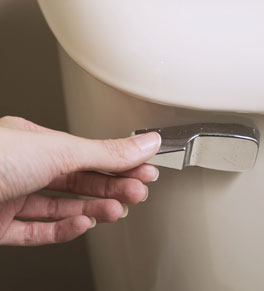The scoop on poop: what’s healthy, what’s not?

What does your poop say about your health? A lot, actually.
The color, shape and consistency of bowel movements may be a reflection of your overall health, says gastroenterologist Dr. C. Gregory Albers, medical director of UCI Health GI Diagnostic Services.
For example, pale stools can signal a problem with the gall bladder, pancreas or liver. Narrow stools may suggest a blockage. Very dark stools may indicate internal bleeding.
Albers, who also is a professor of gastroenterology at the UCI School of Medicine, explains what’s normal and when it’s time to see a doctor.
Assessing bowel health
Elimination varies from person to person, but generally here are some basics:
- Bowel movements are considered normal if they occur up to three times a day or three times a week.
- Most bowel movements are brown. The color comes from bilirubin in bile, which helps break down dietary fats into fatty acids and is produced by your liver and stored in your gallbladder.
- Stools are considered normal if they are easy to pass. One watery bowel movement a day is diarrhea; one hard stool a day is considered constipation.
But constipation also involves secondary symptoms such as straining and bloating, even with twice daily bowel movements, Albers says. Diarrhea refers to loose watery stools, especially in large volumes.
When a stool isn’t brown
The color of your bowel movements may tell your doctor a lot more about your health than its shape or consistency.
- Black stools may be a sign of bleeding in the upper gastrointestinal tract. But if the stool is tar-like and sticky in consistency, Albers says it’s time to get to the emergency room.
- Pale stools may be a sign of a bile duct blocked by anything from a stone to a tumor. This serious condition may be accompanied by jaundice and itchiness and should be evaluated by a doctor, although there are other things, including certain medicines, that can cause pale stools, Albers says.
- Yellow, greasy and foul-smelling stools that float indicates a problem digesting and absorbing fat. People with this condition who also are experiencing weight loss should get a doctor’s evaluation.
- Maroon or red stools may indicate bleeding in the lower gastrointestinal tract and always needs to be investigated.
Off-color isn’t always unhealthy
Although reddish stools often signal a serious condition that needs urgent attention, it also can be caused by other factors.
Albers recalls performing an emergency colonoscopy on a patient with blood-red stools only to find nothing wrong. On further investigation, he learned that the patient had recently eaten a huge plate of red beets.
Stool color is often a sign of what you eat, how foods move through your gut and the medications you’re taking rather than a medical condition. For example:
- Red stools can come not only from eating red beets, but also from red dyes in foods like popsicles and Jell-O.
- Black licorice, Pepto-Bismol, Kaopectate and even iron supplements may turn stools black.
- Green stools can result from eating a lot of kale. Your body absorbs the nutrients, but can’t digest the leaves, themselves. Sometimes iron may also be the culprit.
- Yellow or green stools also can result from colonoscopy prep or diarrhea, when things move though the colon so fast there’s no time to digest the bile.
- Medicines like Kaopectate and Pepto-Bismol may also result in pale stools.
- The stools of breast-fed babies is often yellow.
What about shape?
Healthy stools come out in either smallish pieces or snake-like coils.
Most people have an idea what constipation and diarrhea are. But constipation also involves secondary symptoms such as straining and bloating, even with twice daily bowel movements, Albers says. Diarrhea refers to loose watery stools, especially in large volumes.
A few other things also affect shape and consistency:
- Stools that look like rabbit pellets may be more a dietary problem than a medical one that can be resolved by adding more dietary fiber from fruits and vegetables.
- Fluffy stools can result from fiber supplements.
- Pencil-thin stools are something patients are sometimes concerned with. They could indicate a tumor, but most often Albers says doesn’t find one. Still, they should be evaluated.
Albers sees patients at the UCI Health H.H. Chao Comprehensive Digestive Disease Center in Orange and at UCI Health Gottschalk Medical Plaza in Irvine.




